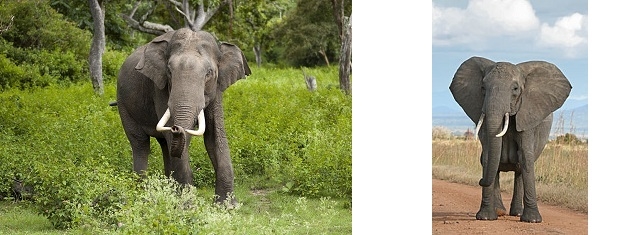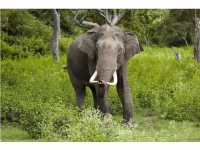Lifestyle
Despite positive trends poaching of African elephants still -unacceptably high-
Face serious threats to their survival

Asian elephant- Female African Bush Elephant (Source: Wikipedia)
Many African elephants continued to face serious threats to their survival in 2015 from the illegal trade in ivory and unacceptably high levels of poaching, although the sharp upward trends in poaching since 2006 have started to level off, according to the Secretariat of the United Nations-backed treaty regulating wildlife trade.
'There are some encouraging signs' but 'much more remains to be done,' said John E. Scanlon, the Secretary-General of the Convention on International Trade in Endangered Species of Wild Fauna and Flora (CITES) in a press release.
'There are some encouraging signs' but 'much more remains to be done,' said John E. Scanlon, the Secretary-General of the Convention on International Trade in Endangered Species of Wild Fauna and Flora (CITES) in a press release.
'The momentum generated over the past five years is translating into deeper and stronger efforts to fight poaching and illicit trafficking on the front-lines, where it is needed most ““ from the rangers in the field, to police and customs at ports of entry and exit and across illicit markets,' he added.
The two CITES monitoring programmes ““ the Elephant Trade Information System (ETIS) and the Monitoring the Illegal Killing of Elephants (MIKE) ““ will present their reports, which contain these findings, to the conference of the treaty parties in September.
The two CITES monitoring programmes ““ the Elephant Trade Information System (ETIS) and the Monitoring the Illegal Killing of Elephants (MIKE) ““ will present their reports, which contain these findings, to the conference of the treaty parties in September.
The reports indicate that the sharp upward trends in poaching, which started in 2006, have started to level off with continental levels of illegal killing of elephants stabilizing or slightly decreasing. However, the levels of poaching remain far too high to allow elephant populations to recover, with some populations facing risk of local extinction, the reports say.
The ETIS report shows that in 2012 and 2013, levels of illegal ivory trade reached their highest levels since CITES agreed to ban the commercial trade in raw ivory in 1989.
The ETIS report shows that in 2012 and 2013, levels of illegal ivory trade reached their highest levels since CITES agreed to ban the commercial trade in raw ivory in 1989.
The results for 2014, the most recent year with sufficient seizure data available for analysis, suggests that illicit trade in ivory began to level off at that point, and this mostly for transactions described as being in the small worked ivory weight class. Additional data in subsequent years is required to confirm a meaningful decline in the illicit ivory trade.
The ETIS report makes some specific suggestions, including greater and more focused commitment on the investigation of large-scale ivory seizures along the entire trade chain, scaled-up forensic examinations to source the origins of the ivory, and the establishment of itemized inventory lists of the contents of seizures.
The MIKE figures show that the steady increase in levels of illegal killing of elephants since 2006, which peaked in 2011, has been halted and stabilized, but that levels remain unacceptably high overall.
The MIKE figures show that the steady increase in levels of illegal killing of elephants since 2006, which peaked in 2011, has been halted and stabilized, but that levels remain unacceptably high overall.
The report estimates that the number of elephants illegally killed annually in Africa between 2010 and 2015 ran into the tens of thousands. Although overall trends are moving in the right direction, elephant poaching in 2015 remains a cause for serious concern, it says.
Illegal killings far exceeding natural deaths in Central and West Africa :
The figures show that Southern Africa is the only sub-region that has not seen illegal killings exceed natural deaths since MIKE monitoring began in the early 2000s. But for the first time, a spike in elephant poaching was observed in South Africa's Kruger National Park. The elephant population in the park is not in decline, but the situation could change if current trends continue.
Illegal killings far exceeding natural deaths in Central and West Africa :
The figures show that Southern Africa is the only sub-region that has not seen illegal killings exceed natural deaths since MIKE monitoring began in the early 2000s. But for the first time, a spike in elephant poaching was observed in South Africa's Kruger National Park. The elephant population in the park is not in decline, but the situation could change if current trends continue.
Positive news comes from East Africa, where estimated poaching levels declined in 2015 for the fourth consecutive year. While poaching evidently increased in parts of the United Republic of Tanzania, Kenya recorded lower levels of poaching.
The most serious levels of poaching were again recorded in Central and West Africa, where illegal killings continue to far exceed natural deaths.
The most serious levels of poaching were again recorded in Central and West Africa, where illegal killings continue to far exceed natural deaths.
'Governments must continue to strengthen their efforts right across the illegal ivory supply chain, while international bodies and civil society must further enhance their much-needed support if we are to reverse the devastating poaching trends of the past decade,' said Mr. Scanlon.
Source : United Nations
Ruby BIRD
http://www.portfolio.uspa24.com/
Yasmina BEDDOU
http://www.yasmina-beddou.uspa24.com/
Source : United Nations
Ruby BIRD
http://www.portfolio.uspa24.com/
Yasmina BEDDOU
http://www.yasmina-beddou.uspa24.com/
Ruby Bird Yasmina Beddou Unacceptably High Poaching African Elephants United Nations Threats Survival Positive Trends Treaty Regulating Wildlife Trade
Liability for this article lies with the author, who also holds the copyright. Editorial content from USPA may be quoted on other websites as long as the quote comprises no more than 5% of the entire text, is marked as such and the source is named (via hyperlink).






